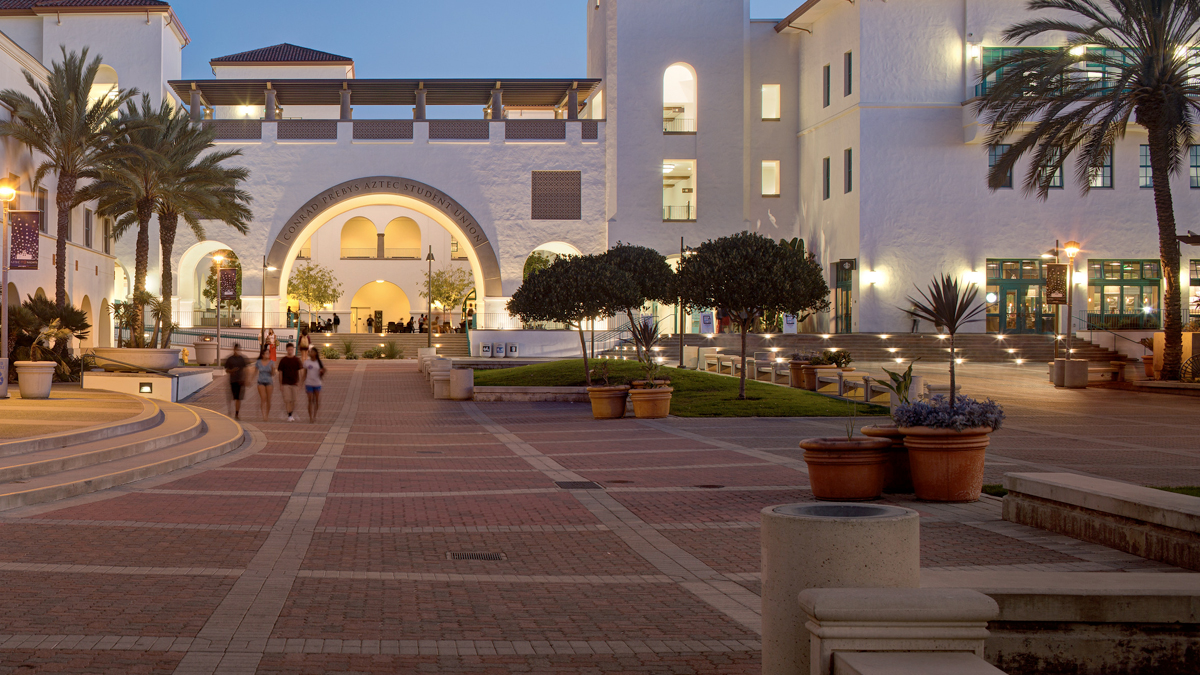A thriving village: First-gen students and families flock to SDSU welcome event

As she prepared to host a welcome event for future first-generation college students and their families at San Diego State University, Wendy Ochoa was haunted by one lingering question.
What if no one shows up?
As it turned out, there was no cause to worry. Interest was so high the assistant professor in child and family development had to close the registration form early.
More than 80 attendees filled a room at the Conrad Prebys Aztec Student Union on April 14 for the kickoff of It Takes A Village, a California State University-funded project to empower first-gen students through family engagement. The initiative is a labor of love led by Ochoa and Rosie Villafana-Hatcher, director of the Early Assessment Program in SDSU’s Office of Educational Opportunity Programs, Outreach and Success, and supported by a team of dedicated students.
“It was a chance for future and current students to meet each other and for us to get to know their families,” Ochoa explains, “We know that for many first-gen students from minoritized backgrounds, families and caregivers are a key source of support.
“So we essentially wanted to set that tone.”
The majority of the attendees were Latinx middle and high schoolers and their immigrant families from the Sweetwater High School District in San Diego’s South Bay area. As most speak Spanish at home, the event program was offered primarily in Spanish, with a bit of English and no shortage of Spanglish mixed in.
The festivities started with introductory icebreaker activities before splitting up into rotating breakout sessions with a format akin to speed dating. In one, Ochoa and Villafana-Hatcher discussed pathways to success. In another, five SDSU students shared their experiences and challenges. Finally, a pair of visiting faculty members — Guadalupe Díaz Lara from Cal State-Fullerton and Paula Alonqueo Boudonx from Universidad de la Frontera-Temuco in Chile — provided information about academic expectations in the classroom.
“Most of our team members are first-generation college students, too, so we know that it takes a village to survive and thrive,” Ochoa said. “So the program is designed to create more of a community between first-gen students and families and SDSU staff, students and faculty.”
The welcome session served as an opportunity to see what kind of questions and concerns families had so they could later be addressed in a subsequent workshop series. Five workshops are scheduled for May and early June, to be hosted at SDSU’s Latinx Resource Center and at school sites in the Sweetwater district.
The feedback they received ran the gamut. Family members were most eager to learn about financial aid options and how they could support their student’s success generally. Students were interested in resources to promote mental health, as well as how they might be able to leverage their experiences and cultures as they navigate college.
One key to the project’s success, Ochoa said, was the involvement of current SDSU students in the planning and implementation of the event. Jyoti Nayak, Brianna Maldonado, Marquita Scott, Aoi Mori, Maria Castillo and Sim Scano have been integral parts of the It Takes a Village Team.
Ochoa said families expressed appreciation to these students for offering their perspectives and having a genuine interest in connecting with them while creating an atmosphere where families did not feel judged.
“My goal was for the (SDSU) students to take ownership of the event because they had a lot to contribute themselves, coming from first-gen or minoritized backgrounds,” Ochoa said. “Their input is what helped shape the structure of the event and the types of activities we did with families and students. I am particularly grateful that they felt comfortable to tell me, ‘I don’t think that’s going to work, professor,’ to some of the ideas I had while we were planning the event and workshops.
“I really liked what they created. They are my village too.”

